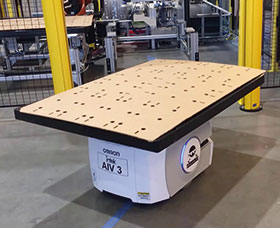

Showcasing flexible production in real life, a new ‘Smart Factory’ in Norway uses a variety of robots in a system developed and implemented by system integrator Intek Engineering.
A dozen industrial robots, each in individual workstations or cells, perform different steps in the manufacturing process. However, to attain the high efficiency, safety, and convenience of a modern smart factory, Intek Engineering needed to link the cells together in an intelligent way. The company chose Omron’s LD mobile robots and Enterprise Management software to achieve this.
“The manufacturer wanted a flexible production solution that could deliver very high efficiency and low changeover times,” says Sølvar Flatmo, chief strategy officer at Intek Engineering. “Combining our experience in flexible production equipment with technology like the Omron LD is a game changer for creating flexible and customisable production lines that can be reconfigured and even changed on-the-fly during production. For high-efficiency production, keeping the robots working continually is a requirement and for this line, fast changeover times and minimal downtime are essential.”
High speed precision
Omron’s LD robots travel at an impressive speed – up to 1,8 m/s. Yet they easily move their 85 cm wide body in and out of the 95 cm robot cells without any trouble. Thanks to their double guide sensors, using special magnetic bands in the floor, the robots can align themselves with millimetre precision. It is this accuracy that helps accelerate production processes.
In addition to their speed and accuracy, LD robots can operate in areas that could be hazardous, or even dangerous, for personnel such as those working in refrigerated stores or heated rooms. They are also ideal for cleanroom facilities such as in semiconductor or pharmaceutical markets where the presence of human operators could contaminate the process.
Supporting production cells
The production line in the new factory uses eight LD robots to support the production cells. The mobile robots are controlled by Omron’s Enterprise Manager, which plans and coordinates all movements in the system. It acts as the central brain – a robot within a robot. It is given the ‘map’ of the production system and it decides which robots go where, based on several factors from position to battery level, aimed at maximising efficiency. Like the rest of the system, the Enterprise Manager acts fast, making decisions on the fly so no time is lost.
Together, this delivers high overall efficiency. The Enterprise Manager ensures that a mobile robot is always waiting to pick up finished production from a cell and move it to the next stage. It also checks if a robot needs to charge, so will send a robot to the charging station, even for just a short period during operation, to give a battery a charge boost. Obviously, during scheduled downtimes, it will send all the robots to charge.
The Enterprise Manager also makes it easy to expand an installation with additional robots. When a new robot is added, it does not need any additional programming. The Enterprise Manager simply adds it to its available pool and gives it instructions on where to go.
Safety first
The industrial robots at the plant operate at high speed which means that it is dangerous for personnel to enter the production cells while they are in operation. Therefore, each cell has a laser screen that can detect if someone enters the cell, and automatically shuts down the system. However, the LD robots also need to enter the cells to take the products to the next production stage. As a result, the Enterprise Manager can inform the cells when a robot is about to enter, so that it does not trigger an emergency shutdown when the robot passes through the laser screen.
When moving between cells, the robots use their own sensors to detect if a person or object is in their way and will move around obstacles or stop to let people pass by. So, even though the fully automated production line only needs a few operators and maintenance personnel to run, these can safely work in the same spaces as the LD robots.
| Tel: | +27 11 579 2600 |
| Email: | [email protected] |
| www: | www.industrial.omron.co.za |
| Articles: | More information and articles about Omron Electronics |

© Technews Publishing (Pty) Ltd | All Rights Reserved